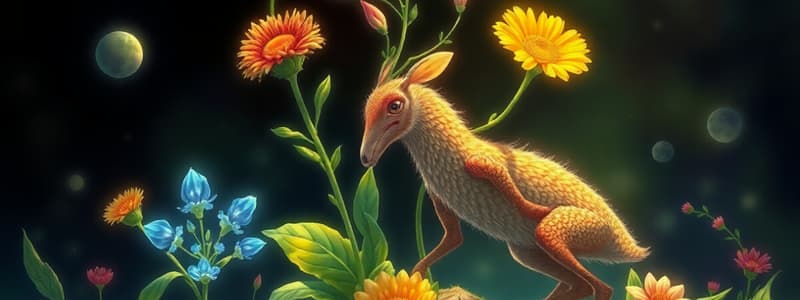Podcast
Questions and Answers
What type of tissue in plants continues to divide throughout their life?
What type of tissue in plants continues to divide throughout their life?
- Meristematic tissue (correct)
- Supportive tissue
- Permanent tissue
- Vascular tissue
In what way do animals differ from plants regarding movement?
In what way do animals differ from plants regarding movement?
- Animals are stationary.
- Animals move to seek food and shelter. (correct)
- Animals have supportive tissues similar to plants.
- Animals cannot seek food.
Why do plants require more supportive tissue compared to animals?
Why do plants require more supportive tissue compared to animals?
- Because supportive tissue in animals is primarily made up of dead cells.
- Because plants are metabolically more active.
- Because plants grow uniformly without regions of division.
- Because plants are stationary and need to remain upright. (correct)
How does the growth pattern in animals differ from that in plants?
How does the growth pattern in animals differ from that in plants?
What reflects the differences in organ systems between plants and complex animals?
What reflects the differences in organ systems between plants and complex animals?
Flashcards
Plant vs. Animal Differences
Plant vs. Animal Differences
Plants are stationary, have more supportive tissue (usually dead cells) for upright growth; animals move for food, mates, and shelter, needing more energy and living tissues.
Plant Growth
Plant Growth
Limited to specific growth regions (meristematic tissue) where cells actively divide throughout plant life. The rest of the tissue is permanent.
Animal Growth
Animal Growth
Growth is generally uniform across the body; no distinct dividing or non-dividing regions.
Plant Tissues
Plant Tissues
Signup and view all the flashcards
Animal Organ Systems
Animal Organ Systems
Signup and view all the flashcards
Study Notes
Plant vs. Animal Differences
- Movement: Plants are stationary, while animals move. This difference impacts their structures and needs.
- Support System: Plants have more supportive tissue, typically composed of dead cells, to maintain their upright positions.
- Energy Requirements: Animals need more energy than plants due to their movement for food, mates, and shelter. Animal tissues are mostly living.
- Growth: Plant growth is limited to specific regions (meristematic tissue). Animals have more uniform growth everywhere.
- Tissues: Plants have meristematic (dividing) and permanent tissues. Animals do not have distinct dividing and non-dividing regions.
- Organ and Organ System Complexity: Animal organ systems are more specialized and localized compared to plants, reflecting their diverse lifestyles, feeding habits, and locomotion abilities.
- Sedentary vs. Active Lifestyles: Plants are sedentary, while animals are active. This difference in lifestyle is directly reflected in the design of their respective organ systems.
Studying That Suits You
Use AI to generate personalized quizzes and flashcards to suit your learning preferences.




